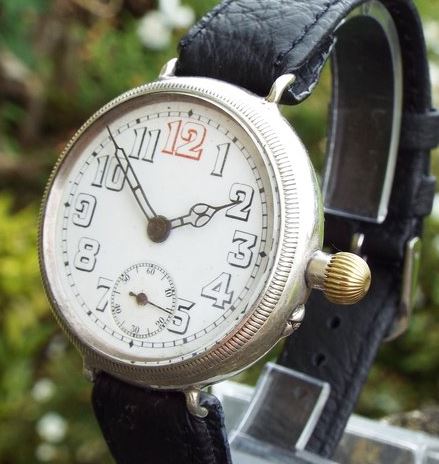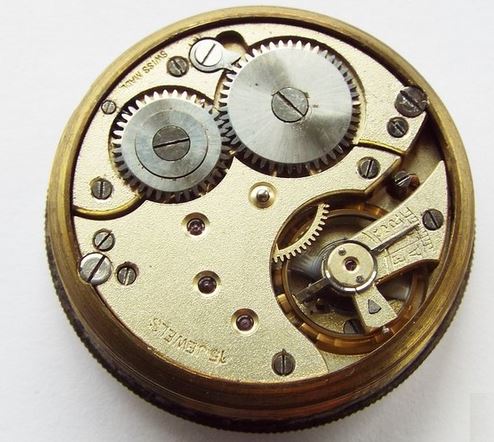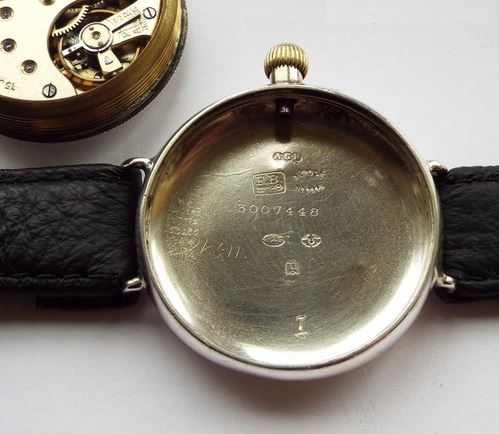Last updated on July 2, 2024
Anyone who has read some of my previous posts will know that a Borgel trench watch is high of my wish list. I like to turn over my collection, buying a watch and admiring it for a while. I will wear it to a few events and then sell it on to fund my next purchase. However, the Borgel is just about the Holy Grail for me, so when I do get one, it is likely to be part of my permanent collection. I am on the constant lookout for World War 1 period Borgel watch and stumbled across this fine example recently. It is a silver Borgel cased trench watch made by the General Watch Company in 1915.

The General Watch Company
The history of the General Watch Company watch goes back to 1848 when Louis Brandt established a business as a watchmaker. In the beginning, Brandt assembled key-wound pocket watches made from parts supplied by local craftsmen. He sold his watches throughout Europe, with England being his primary market. Louis Brandt died in 1879 and his sons, Louis-Paul and César, took over the family business.
In 1880, Louis-Paul and César set up an in-house watch manufacturing business, La Generale Watch Co (General Watch Company). Obviously, brand names for their product were required and the two brothers selected a number of names for their watches. One of these brands was Helvetia, which is the female personification of the Swiss nation.
The watches produced by the Brandt brothers were highly respected. In 1885 they began incorporating the new lever movements in their watches. They were able to produce watches that were accurate to within 30 seconds per day, which was an incredible achievement at the time. By 1890 the General Watch company was producing more than 100,000 watches per year and became the largest producer of watches in Switzerland. In 1892 the brothers produced the world’s first minute-repeating wristwatch. This watch had a slide at the 3 o’clock position that could be moved to trigger a striking mechanism that would chime the minutes and hours. Wristwatches at the time were unusual and seen as more of an accessory than a serious timepiece. This was way ahead of its time bearing in mind that wristwatches only gained popularity during World War 1.
Omega
By 1894 the General Watch Company had developed a new type of watch movement incorporating the revolutionary idea of having component parts that were interchangeable. This decreased manufacturing costs making the manufacture of watches more efficient and also made watch repair easier. Watches developed with these techniques were marketed under the Omega brand of La Generale Watch Co. The Omega brand was a tremendous success and by 1903 it was decided that Omega would split from the General Watch Company as an independent enterprise, with the General Watch Company focusing its attention on the manufacture of cylinder watches under the trade name Helvetia.
Movement
The watch has a Swiss 15-jewel, hand-winding, pin-set movement. The movement is clean, with no obvious signs of corrosion. It is working to within two minutes accuracy over 24 hours. This level of accuracy makes it a reliable timepiece for daily use.

The watch itself measures 34.5mm in diameter excluding the winding crown and the fixed wire lugs. The case is silver and there are hallmarks inside the case back for London (import mark), 1915, together with an importer’s (or sponsor’s) mark AGR.
In 1907, an act came into force which meant that all imported watches had to be assayed in a British Assay office and marked with British import hallmarks. For this, a sponsor’s mark was required. The hallmarking of foreign-made cases was strictly enforced by Customs. In this particular example, Arthur George Rendell (AGR) was a senior employee at Robert Pringle & Sons who were a major wholesale supplier of quality silver goods.
Borgel case
The case also has the mark for François Borgel (FB), which had been officially registered in 1887. This mark is visible in all Borgel cases. Francois Borgel was born in Geneva in 1856. In 1880, at the age of 24, he started a business as a watch case fitter. Borgel was a talented inventor and successful businessman. The Borgel company became one of the most important watch case manufacturers of its time. He advertised his screw watch case, such as this example, as “imperméable”. This indicated that he considered his screw case design to be waterproof. Early adopters of the Borgel screw case included Longines and IWC. After François Borgel’s death in 1912, the business was carried on by his daughter Louisa.

When the First World War broke out it soon became evident that an accurate timepiece was critical in the trenches. This is where the Borgel case came to the front. It was rugged, dust-proof and by all accounts waterproof. They were expensive compared to other wristwatches at the time. However, no expense would be spared by the men in the trenches for this potentially life-saving device.
Case
Overall, the case is in good condition for its age, there is a small dent on the back of the case. That is not unusual for an antique watch and it is certainly not visible when the watch is being worn. Unfortunately, engraved on the back of the watch is a previous owner’s name. This is a showstopper for me. I don’t buy these antique watches as an investment, but I do think that personal engravings detract from the resale value. Although Borgel claimed his watch case was waterproof, you would not risk exposing a watch of this age to water.
Dial
The white enamel dial is in good condition. Originally, there probably would have been luminous paint applied to the numbers and the hands, but this has been removed over the years. The hands are initially set by way of the pin set mechanism. The lens is in good condition with no visible scratches.
Summary
This is a near-perfect example of what I am looking for. It is presentable and reliable enough for me to use over the course of a working day or for a social event. However, I just can’t get past the personalised engraving on the back of the case. Subconsciously, I would be questioning my right to ownership. I did enjoy researching this antique trench watch and by the time I had finished, someone else had purchased the watch. I hope they enjoy their timepiece.

I have a Borgel that has been handed down as a family heirloom. It is a S Smith & Sons First World War Borgel patented trench watch. It has a Longines caliber 13.34 movement with a Breguet overcoil hairspring. All is original except a replacement mainspring as this was broken in the 1960s. The original crystal has a purple tint to it. The black dial and hand lume is all original. The strap buckle dates from about 1920, and is an S.Smith signed one. This watch is all in lovely unpolished condition, showing its age nicely.
This is a big wristwatch for the period at 35mm, excluding the winding crown. It is a pin-set movement, so you need to press the pin below the crown to release the hands for setting the time.
The case is unscrewed from the top by pulling the crown right out to the sleeve end and turning anti-clockwise. This has long good threads and is hard to re-close, no dead threads jumping here! It can be a challenge screwing the case back in and getting it all aligned!
Time keeping is sensible and the movement is in perfect condition. Movement is stamped ab for Baume the importer of Longines into the UK. The case is also stamped with the import mark and the date letter 1917. I wear it on special occasions.
Hi Freddy, that sounds like a beautiful timepiece. I have a Mappin Campaign watch with the Longines 13.34 movement. The unpolished condition or patina on your Smiths trench watch is highly valued by collectors who prefer antique watches in original condition. The Borgel cases can be challenging when screwing back in, I certainly know that from experience. Thanks very much for taking the time to comment, I hope you enjoy wearing your Smith & Sons trench watch, Jason.
I have a Borgel-cased trench watch with 15-jewel GWC movement identical to the one you described. No dents or engraving on the case, no chips or cracks on the dial, numbers and lume (very faint) intact, hands good. FB mark inside the case.
I have recently found this is my father’s collection – he died earlier this year, and was a clock and watch repairer (and collector) for over 50 years.
It keeps perfect time for a watch that is over 100 years old…
Hi Brian, sorry to hear about your fathers passing. Keep good care of that GWC trench watch, it sounds like the perfect example of its type. If the luminous paint is still on the hands and dial, please be aware that it will still be radioactive. It is amazing how well these watch can still keep accurate time after a century or more. Just be aware that the lubricant in the movement will dry out over time and that the occasional service will be required. Thanks for taking the time to comment, enjoy your antique tranch watch, Jason.